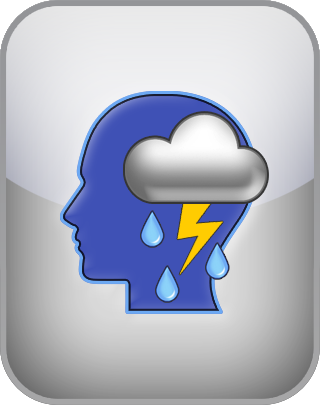Academically reviewed by Dr. Sabina Alispahić, Ph.D., professor of psychology
Depression Type Test
Research into neurological markers for depression by Leonardo Tozzi and colleagues at Stanford University has revealed six distinct types of depression. This test assesses characteristics associated with these six types to provide a clearer picture of the neurological basis of depression.
To take the test, enter your input below.
Question 1 of 30
I often lose my focus during tasks.
| Disagree | Agree |
NEXT
The IDRLabs Depression Subtype Test (DST-30) is developed by IDRLabs. The IDRLabs Depression Subtype Test (DST-30) is inspired by psychometric methodology and research by Leonardo Tozzi and colleagues at the Department of Psychiatry and Behavioral Sciences at Stanford University. IDRLabs is not affiliated with authors or institutions.
The test provides feedback such as the following:
Cognitive Hyperactivity Depression: This type of depression is characterized by excessive activity in brain regions involved in cognitive processing. It pertains to individuals who experience heightened levels of thinking, often manifesting as overthinking and difficulty concentrating. This type of depression represents a symptomatology where the mind is persistently active, leading to a racing stream of thoughts and challenges in focusing on specific tasks. Such individuals frequently find their cognitive functions overwhelmed, resulting in a continuous struggle to manage their thoughts effectively. Individuals struggling with this type of depression may exhibit signs of cognitive overload, with their mental processes constantly engaged, even in situations that do not otherwise require intensive cognitive effort.
Resting Hyperactivity Depression: Denotes a type of depression characterized by elevated activity levels in specific brain regions even at rest. It is frequently observed in individuals who exhibit persistent restlessness and continuous mental engagement, even during periods of inactivity. This type of depression represents symptomatology marked by a chronic inability to relax, leading to feelings of constant agitation and an ongoing need to solve problems or engage in cognitive tasks. Individuals with this type of depression often struggle to achieve a state of mental calmness, finding themselves perpetually active mentally, which interferes with their ability to rest and recuperate. The heightened baseline activity in these brain regions underpins their continuous sense of unrest and difficulty achieving relaxation.
Attention Hypoactivity Depression: This type of depression is characterized by diminished activity in brain regions responsible for attention control. It is often observed in individuals who exhibit significant difficulties in maintaining focus and sustaining attention. This depression type represents a symptomatology marked by distractibility, an inability to concentrate for extended periods of time, and challenges in completing tasks. Individuals with this type of depression often struggle to engage with their surroundings, leading to a poor attention span and a propensity to become sidetracked. The reduced activity in their attention-control neurocircuit impairs their capacity to maintain consistent cognitive engagement, resulting in persistent lapses in attention and a notable decrease in productivity and cognitive function.
Network Hyperconnectivity Depression: Is a type of depression characterized by hyperconnectivity within key brain circuits. It refers to individuals who experience slow emotional and attentional responses due to heightened connectivity in their default brain mode, salience, and attention circuits. This depression type represents a symptom profile marked by delayed emotional reactions, difficulty shifting focus, and challenges in regulating emotions. Individuals with this type of depression often struggle with attentional flexibility and emotional adaptability, experiencing prolonged and intense emotional states. Their cognitive and emotional processing is less efficient, leading to persistent difficulty in managing everyday tasks that require quick emotional and attentional shifts.
Attention Hypoconnectivity Depression: Denotes a type of depression characterized by reduced intrinsic connectivity within brain circuits responsible for attention. It is chiefly observed in individuals who experience significant lapses in concentration and heightened impulsivity. This type of depression comes with a symptomatology where the attention span is severely compromised, leading to frequent distractions and difficulties maintaining a steady focus on tasks. As a consequence, individuals with this type of depression often act impulsively, being unable to marshal prolonged mental effort. Their cognitive processes exhibit marked inconsistencies, with notable struggles in tasks requiring sustained attention and concentration. These symptoms collectively contribute to a pervasive sense of cognitive disorganization and diminished capacity for controlled, deliberate thinking.
Emotional Hyperactivity Depression: Describes a type of depression characterized by increased activity in brain regions associated with emotional processing. It is often observed in individuals who exhibit heightened responses to both positive and negative emotional stimuli. This depression type denotes a symptomatology where there is a pervasive anhedonia, or loss of pleasure, coupled with ruminative thinking. Individuals with this type of depression often experience intense and frequent negative thoughts, leading to a persistent state of emotional turmoil. The heightened activity in emotion processing circuits results in an amplified perception of emotional events, causing significant distress and impairment in daily functioning. This depression type is marked by a profound inability to derive joy from previously enjoyable activities, contributing to a deeply entrenched depressive state.
The IDRLabs Depression Subtype Test (DST-30) is inspired by psychometric methodology and scientific findings pertaining to depression biotypes. While the IDRLabs Depression Subtype Test (DST-30) is inspired by scientific research, it cannot be used to provide clinical assessments or an accurate evaluation of your features. Clinical assessments should always be done in cooperation with a mental health professional. For more information about any of our online tests and quizzes, please consult our Terms of Service.
References
- Tozzi et al. (2024). Personalized brain circuit scores identify clinically distinct biotypes in depression and anxiety. Nature Medicine.

